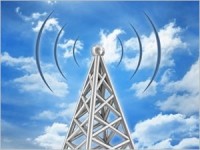Feeder killer

Connect the world via RF from anywhere in the world with your smartphone.
Anyone knows that a transceiver use to be linked to some antenna system using a transmission line such as coaxial cable, ladder line, just to name a few. Whatever it is, the transmission line generate lots of concerns such as loss, matching complexity, cost, reliability, radio frequency interference, installation constraints, ... in conclusion it would be nice to escape all those drawback.
To do so, the idea is to locate the transceiver at the feeding point of the antenna avoiding any need for some transmission line. This option is ideal from the RF point of view.Of course In that case the man machine interface would have to be performed remotely. Thanks to the beauty of the esp32, this can be done in a very elegant manner. The GPIO and other ESP I/O pins will care about supervision of the transceiver while the wifi module will connect directly to the user smartphone (and appropriate application) or to some local router then to internet. No matter where the user is located, the full control of the system remain available at any time.
At this stage of the project we are basically consider some digital (e.g. PSK31 ) and morse ( CW ) transmission classes using low RF power (=<5watt) so called QRP in the radio amateur world. WSPR would be a favourite candidate as well. Any of the transceiver required for the above mode of transmission can easily be batteries powered and properly selected batteries can last for days in these applications. Solar cells refueling can be considered too. In addition those kind of transceiver are light weight and can easily be enclosed in a waterproof box.
To summarize the complete system (antenna + transceiver) save plenty of physical constraints, it require only some mechanical support and possibly a ground connection depending on the type of aerial. Potentialy it can be controlled from anywhere in the world.
Thanks for reading, hope you liked it a bit.
To do so, the idea is to locate the transceiver at the feeding point of the antenna avoiding any need for some transmission line. This option is ideal from the RF point of view.Of course In that case the man machine interface would have to be performed remotely. Thanks to the beauty of the esp32, this can be done in a very elegant manner. The GPIO and other ESP I/O pins will care about supervision of the transceiver while the wifi module will connect directly to the user smartphone (and appropriate application) or to some local router then to internet. No matter where the user is located, the full control of the system remain available at any time.
At this stage of the project we are basically consider some digital (e.g. PSK31 ) and morse ( CW ) transmission classes using low RF power (=<5watt) so called QRP in the radio amateur world. WSPR would be a favourite candidate as well. Any of the transceiver required for the above mode of transmission can easily be batteries powered and properly selected batteries can last for days in these applications. Solar cells refueling can be considered too. In addition those kind of transceiver are light weight and can easily be enclosed in a waterproof box.
To summarize the complete system (antenna + transceiver) save plenty of physical constraints, it require only some mechanical support and possibly a ground connection depending on the type of aerial. Potentialy it can be controlled from anywhere in the world.
Thanks for reading, hope you liked it a bit.




Discussion (0 comments)